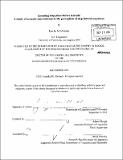| dc.contributor.advisor | Adam Albright. | en_US |
| dc.contributor.author | Michaels, Jennifer M. (Jennifer Marie) | en_US |
| dc.contributor.other | Massachusetts Institute of Technology. Dept. of Linguistics and Philosophy. | en_US |
| dc.date.accessioned | 2012-01-12T19:34:10Z | |
| dc.date.available | 2012-01-12T19:34:10Z | |
| dc.date.copyright | 2011 | en_US |
| dc.date.issued | 2011 | en_US |
| dc.identifier.uri | http://hdl.handle.net/1721.1/68518 | |
| dc.description | Thesis (Ph. D.)--Massachusetts Institute of Technology, Dept. of Linguistics and Philosophy, 2011. | en_US |
| dc.description | Cataloged from PDF version of thesis. | en_US |
| dc.description | Includes bibliographical references (p. 175-185). | en_US |
| dc.description.abstract | In phonological analyses of both adult and child language, a *dl constraint has frequently been used as a shorthand to indicate that coronal stops are dispreferred before laterals (Dinnsen et al. 2001). This dispreference has frequently been attributed to the Obligatory Contour Principle (OCP), which prohibits sequences of adjacent identical elements (McCarthy 1979). However, this type of analysis misses the generalization that what languages really seem to lack is the contrast between TL-KL (Flemming 2002). The neutralization of TL-KL contrasts is argued to occur because acoustic cues for coronal and velar stop place are insufficiently distinct in prelateral contexts (Flemming 2002, 2007; Bradley 2006). In this dissertation I address the question of which perceptual dimensions are indistinct for surface contrasts of TL-KL. I capture the perceptual indistinctness of TL-KL contrasts by formalizing constraints that penalize stop place contrasts that crucially lack sufficiently distinct cues for place in both their release transitions and their stop burst properties (Flemming 2007), and show how coronal and velar place contrasts are predicted to be maintained in environments in which (1) at least one of the two cues is available (e.g. before vowels/rhotics) or (2) when other contextual cues are available to license the place contrast. As the threshold of distinctiveness for place contrasts that rules out TL-KL contrasts in a language is predicted to rule out any place contrast that is less distinct for the same cues, the formalization of these constraints make testable predictions about place contrasts in languages more generally, some of which are explored in this dissertation. Another puzzle that arises from adopting a contrast-based analysis for the coronal-stop lateral dispreference involves the outcome of TL-KL contrast neutralization. Why, in languages that show a neutralization of the contrast, is the outcome generally a KL sequence (Flemming 2007)? In my dissertation, I argue that the direction of the neutralization of indistinct surface contrasts, such as TL-KL, is conditioned by the avoidance of other indistinct contrasts. In addition to an indistinct pre-lateral stop place contrast (TL-KL), there are indistinct contrasts involving stop presence (TL-L) that play a role in determining the outcome of neutralizations. | en_US |
| dc.description.statementofresponsibility | by Jennifer M. Michaels. | en_US |
| dc.format.extent | 185 p. | en_US |
| dc.language.iso | eng | en_US |
| dc.publisher | Massachusetts Institute of Technology | en_US |
| dc.rights | M.I.T. theses are protected by
copyright. They may be viewed from this source for any purpose, but
reproduction or distribution in any format is prohibited without written
permission. See provided URL for inquiries about permission. | en_US |
| dc.rights.uri | http://dspace.mit.edu/handle/1721.1/7582 | en_US |
| dc.subject | Linguistics and Philosophy. | en_US |
| dc.title | Licensing stop place before laterals : a study of acoustic cues relevant to the perception of stop-lateral sequences | en_US |
| dc.title.alternative | Study of acoustic cues relevant to the perception of stop-lateral sequences | en_US |
| dc.type | Thesis | en_US |
| dc.description.degree | Ph.D. | en_US |
| dc.contributor.department | Massachusetts Institute of Technology. Department of Linguistics and Philosophy | |
| dc.identifier.oclc | 770746809 | en_US |
